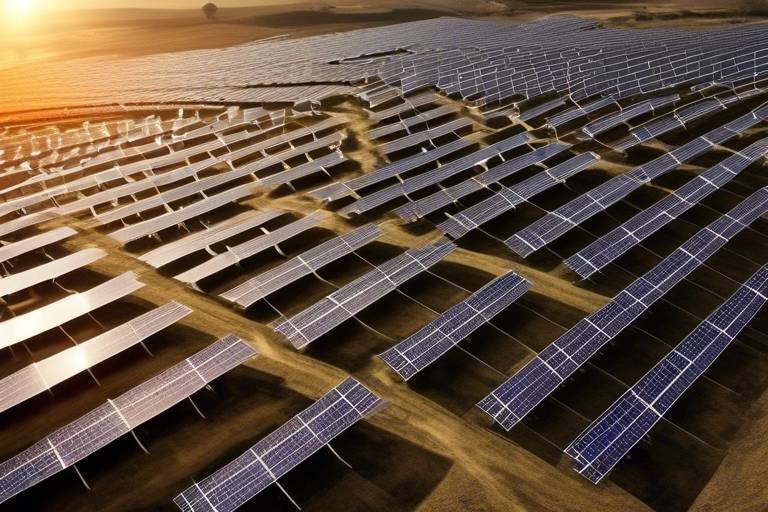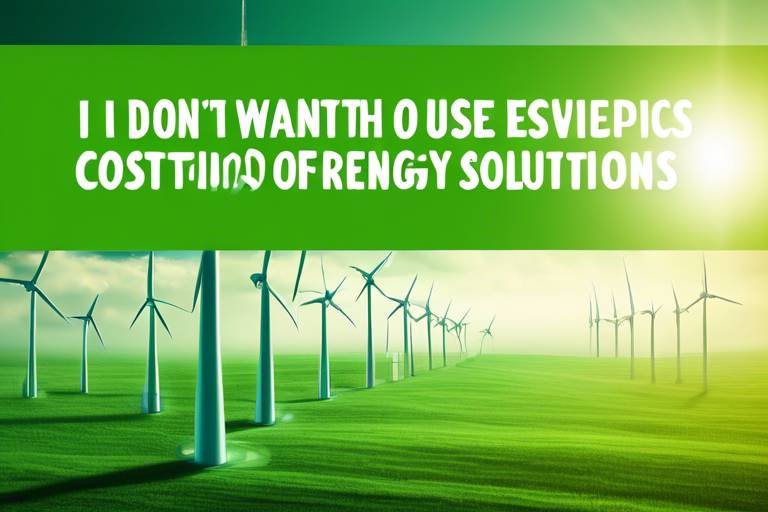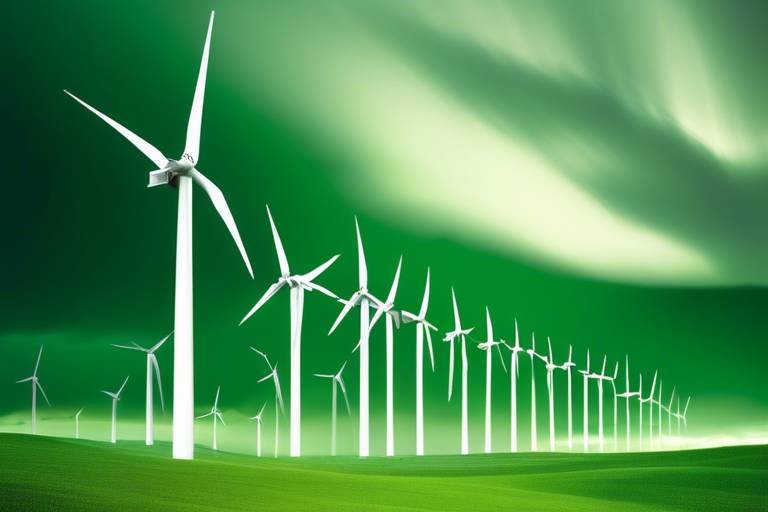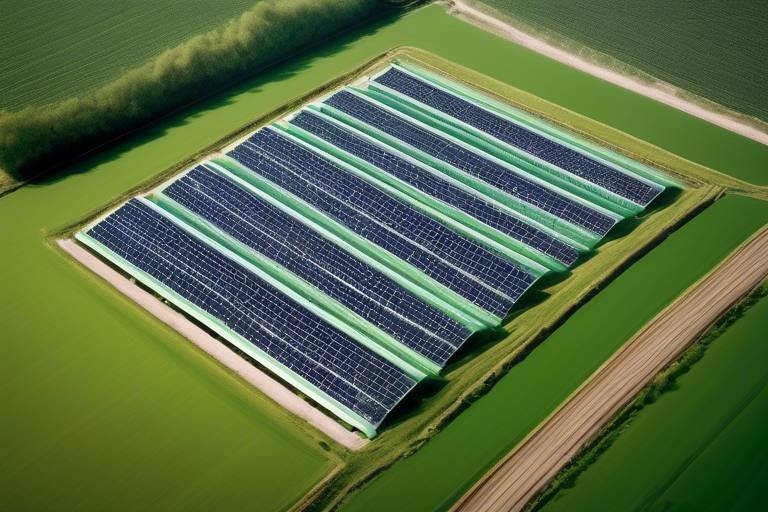The Interrelation between Blockchain and Green Energy Solutions
This article explores how blockchain technology can enhance green energy solutions, examining its benefits, challenges, and potential applications in creating a sustainable energy future. As we stand at the crossroads of technology and environmental stewardship, the intersection of blockchain and renewable energy presents an exciting frontier. Imagine a world where energy transactions are not only secure but also transparent, efficient, and accessible to everyone. This is not just a dream; it’s a very real possibility that blockchain technology is helping to bring to life.
Before diving into the synergy between blockchain and green energy, let's break down what blockchain really is. At its core, blockchain is a decentralized ledger that records transactions across many computers. This means that no single entity has control over the entire chain, which enhances security and transparency. Each transaction is grouped into a block, and once a block is filled, it’s added to the chain in a linear, chronological order. The beauty of blockchain lies in its ability to provide a tamper-proof record of transactions, making it ideal for applications in various sectors, including energy.
Now that we have a grasp of blockchain, let’s talk about why green energy is crucial. Transitioning from fossil fuels to sustainable energy sources is not just a trend; it’s a necessity for a healthier planet. The environmental benefits of green energy are profound. By utilizing renewable sources, we can significantly reduce greenhouse gas emissions, combat climate change, and promote biodiversity. It’s like choosing to nourish our planet rather than deplete it. The urgency of this transition cannot be overstated, especially as we face the consequences of climate change on a global scale.
There are several types of green energy, each with unique advantages. Here’s a brief overview:
- Solar Energy: Harnessing sunlight through photovoltaic cells, solar energy is one of the most accessible forms of renewable energy.
- Wind Energy: Generated by wind turbines, this form of energy is rapidly growing, especially with advancements in turbine technology.
- Hydro Energy: Utilizing the flow of water, hydroelectric power remains one of the most established renewable energy sources.
- Geothermal Energy: Tapping into the Earth’s internal heat, geothermal energy is a reliable and consistent energy source.
Each of these energy types plays a critical role in reducing our carbon footprints and fostering a sustainable energy future.
Recent advancements in solar technology are nothing short of revolutionary. Innovations such as high-efficiency photovoltaic cells and advanced energy storage solutions are making solar energy more accessible and efficient than ever. Imagine being able to store energy generated during sunny days to use during the night. This capability not only maximizes energy use but also minimizes waste, making solar energy a powerhouse in the quest for sustainable solutions.
Wind energy is also experiencing exciting developments, particularly with the rise of offshore wind farms and cutting-edge turbine technology. These advancements are crucial for increasing renewable energy capacity and reducing reliance on fossil fuels. Picture vast fields of turbines spinning gracefully in the ocean breeze, generating clean energy that powers our homes and businesses. It’s a sight that evokes hope for a greener future.
Despite the promise of green energy, several challenges hinder widespread adoption. Regulatory hurdles can complicate the implementation of new technologies, while technological limitations may slow progress. Additionally, financial constraints often prevent individuals and businesses from investing in renewable energy solutions. Addressing these barriers is essential for a smoother transition to a sustainable energy landscape.
So, how does blockchain come into play? One of the most exciting aspects of blockchain technology is its potential to streamline energy transactions. By enabling secure, transparent, and efficient peer-to-peer energy trading, blockchain can revolutionize how we buy and sell energy. Imagine a scenario where you can sell excess energy generated from your solar panels directly to your neighbor, all facilitated by blockchain technology. It’s like having a mini energy market right in your community!
Smart contracts are another game-changer in the energy sector. These self-executing contracts with the terms of the agreement directly written into code can automate energy transactions. This reduces the need for intermediaries and ensures compliance with energy regulations. Think of smart contracts as the digital butlers of the energy market, handling transactions swiftly and accurately.
Blockchain also paves the way for decentralized energy grids, which empower local communities to generate, distribute, and consume energy more efficiently. This concept allows for more resilient and flexible energy distribution systems, making communities less reliant on centralized power sources. Imagine a neighborhood where everyone contributes to a shared energy pool, fostering collaboration and sustainability.
Looking ahead, the integration of blockchain and green energy holds immense potential. Innovations such as decentralized energy markets and enhanced energy management systems could revolutionize how we consume energy. The future is bright, and the possibilities are endless. As we embrace these technologies, we move closer to a sustainable energy future where everyone has access to clean, renewable energy.
Q: How does blockchain improve energy efficiency?
A: Blockchain enhances energy efficiency by enabling direct peer-to-peer transactions, reducing the need for intermediaries, and optimizing energy distribution.
Q: What are the main challenges in adopting green energy?
A: The main challenges include regulatory hurdles, technological limitations, and financial constraints that can impede widespread adoption.
Q: Can blockchain technology help in reducing carbon emissions?
A: Yes, by facilitating renewable energy transactions and promoting decentralized energy systems, blockchain can contribute to reducing carbon emissions.

Understanding Blockchain Technology
Blockchain technology is often hailed as a revolutionary force, and for good reason. At its core, blockchain is a decentralized ledger that records transactions across multiple computers in such a way that the registered transactions cannot be altered retroactively. This means that once data is entered into a blockchain, it becomes a permanent part of the record, fostering a level of security and transparency that traditional systems simply cannot match. Imagine a digital notebook where every entry is locked in place, visible to all, yet tamper-proof—this is the essence of blockchain.
One of the key features of blockchain is its decentralization. Unlike traditional databases that rely on a central authority, blockchain operates on a network of nodes (computers) that validate and record transactions. This distributed nature not only enhances security but also ensures that no single entity has complete control over the data. As a result, blockchain can significantly reduce the risk of fraud and corruption, making it an attractive solution for various sectors, including finance, supply chain, and, of course, energy.
Another important aspect of blockchain is its immutability. Once a transaction is recorded, it is grouped into a block and linked to the previous block, forming a chain. This chain of blocks is protected by cryptographic algorithms, making it nearly impossible to alter any information without altering all subsequent blocks. This feature is crucial for industries that require a high level of trust and accountability, as it ensures that every transaction is verifiable and transparent.
To better understand how blockchain functions, let's break down its main components:
| Component | Description |
|---|---|
| Node | A computer that participates in the blockchain network, validating and relaying transactions. |
| Block | A collection of transactions that are bundled together and added to the blockchain. |
| Chain | The sequence of blocks that forms the complete history of transactions on the blockchain. |
| Consensus Mechanism | The protocol that nodes follow to agree on the validity of transactions (e.g., Proof of Work, Proof of Stake). |
In recent years, blockchain has gained traction in various applications, particularly in the realm of energy. By enabling secure and transparent transactions, it has the potential to transform how energy is produced, distributed, and consumed. Imagine a future where households can sell excess solar energy directly to their neighbors through a blockchain platform, eliminating the need for a central utility company. This kind of peer-to-peer energy trading could not only empower consumers but also foster a more sustainable energy ecosystem.
In summary, understanding blockchain technology is crucial for grasping its potential impact on various sectors, including green energy. Its decentralized nature, immutability, and transparency make it an ideal candidate for enhancing energy solutions, paving the way for a more sustainable and efficient energy future.

The Importance of Green Energy
In today's rapidly changing world, the significance of green energy cannot be overstated. As we grapple with the consequences of climate change, it becomes increasingly clear that transitioning from traditional fossil fuels to sustainable energy sources is not just an option but a necessity. Green energy, derived from natural processes that are replenished constantly, offers a myriad of environmental benefits while paving the way for a healthier planet. But what exactly makes green energy so essential?
Firstly, green energy sources, such as solar, wind, hydro, and geothermal, play a crucial role in reducing our carbon footprint. Unlike fossil fuels, which release significant amounts of carbon dioxide and other greenhouse gases into the atmosphere, renewable energy sources produce little to no emissions during operation. This shift is vital for mitigating the impacts of climate change, which threatens ecosystems, wildlife, and human health alike. The urgency to act is palpable; the longer we rely on fossil fuels, the more severe the consequences will be.
Moreover, the importance of green energy extends beyond environmental benefits. It also contributes to energy security. By diversifying our energy sources, we can reduce dependence on imported fuels, which often come with geopolitical risks and price volatility. Imagine a world where energy is not only abundant but also locally sourced, empowering communities and creating jobs in the renewable sector. This shift can stimulate local economies, providing new opportunities for innovation and growth.
Additionally, the transition to green energy is crucial for promoting sustainable development. As we strive to meet the energy demands of an ever-growing population, we must do so in a way that does not compromise the ability of future generations to meet their own needs. Green energy solutions offer a pathway to sustainable living, ensuring that we harness resources responsibly and equitably. It's not just about the here and now; it's about creating a legacy of sustainability for generations to come.
To further illustrate the importance of green energy, consider the following table, which summarizes the key environmental benefits:
| Green Energy Source | Environmental Benefit |
|---|---|
| Solar Energy | Reduces reliance on fossil fuels and decreases air pollution. |
| Wind Energy | Generates electricity with minimal environmental impact. |
| Hydro Energy | Utilizes water flow to produce clean energy, reducing carbon emissions. |
| Geothermal Energy | Offers a sustainable source of energy with a low carbon footprint. |
In conclusion, the importance of green energy is multifaceted, encompassing environmental, economic, and social dimensions. As we face the daunting challenges of climate change and resource depletion, embracing green energy solutions is not merely a trend but a vital step toward a sustainable future. The question we must ask ourselves is, are we ready to make this shift? The answer lies in our collective commitment to change and innovation.
- What are the main types of green energy? Green energy primarily includes solar, wind, hydro, and geothermal energy.
- How does green energy help combat climate change? By reducing greenhouse gas emissions, green energy sources help mitigate the effects of climate change.
- Can green energy sources provide enough power for large cities? Yes, with advancements in technology and infrastructure, green energy can supply significant power to urban areas.
- What role does government policy play in promoting green energy? Government policies can incentivize the adoption of green energy through subsidies, tax breaks, and regulations.

Types of Green Energy
When we talk about green energy, we're diving into a world of sustainable power sources that are not only environmentally friendly but also essential for a healthier planet. The transition from fossil fuels to these renewable sources is crucial for reducing our carbon footprint and combating climate change. So, what exactly are the types of green energy that are paving the way for this transformation? Let’s explore some of the most prominent ones.
First up, we have solar energy. This powerhouse harnesses the sun's rays to generate electricity through photovoltaic cells. Think of it as capturing sunlight and turning it into usable energy, much like how plants convert sunlight into food through photosynthesis. The beauty of solar energy lies in its accessibility; with advancements in technology, solar panels are becoming more efficient and affordable, making it possible for homes and businesses to generate their own electricity. In fact, solar energy is one of the fastest-growing renewable energy sources worldwide.
Next on our list is wind energy. Imagine standing on a hill, feeling the breeze whip through your hair—that same wind can be converted into energy! Wind turbines, often found in large farms or even offshore, capture the kinetic energy from the wind and turn it into electricity. The recent developments in turbine technology have significantly increased their efficiency, allowing us to harness even more energy from the wind. This not only contributes to energy sustainability but also creates jobs in manufacturing and installation.
Then we have hydropower, which utilizes flowing water to generate electricity. It’s like having a natural battery, where the movement of water—whether from rivers, dams, or waterfalls—turns turbines to produce energy. Hydropower is one of the oldest and most established forms of renewable energy, providing a significant portion of the world's electricity. However, it’s essential to balance its benefits with environmental considerations, as large dams can impact local ecosystems.
Lastly, let’s not forget about geothermal energy. This is the heat that comes from the Earth’s core, which can be used for heating and electricity generation. Think of it as tapping into the planet's natural furnace. Geothermal energy is incredibly efficient and has a low environmental impact, making it a reliable source for sustainable energy. Regions with volcanic activity are particularly suited for geothermal plants, but advancements are allowing us to explore this energy source in more areas.
In summary, the diversity of green energy sources—from solar and wind to hydropower and geothermal—offers a multi-faceted approach to creating a sustainable energy future. Each type comes with its unique advantages and challenges, but collectively, they hold the key to reducing our reliance on fossil fuels and securing a cleaner, greener planet for generations to come.
As we explore these types of green energy, it’s crucial to remember that the integration of these resources into our daily lives is not just a technological shift; it’s a cultural one. Embracing renewable energy means rethinking how we consume and interact with power, paving the way for a more sustainable future.
- What is green energy? Green energy refers to energy derived from natural sources that are replenished at a higher rate than they are consumed, such as solar, wind, and geothermal energy.
- Why is it important to switch to green energy? Transitioning to green energy is vital for reducing greenhouse gas emissions, combating climate change, and ensuring a sustainable energy supply for future generations.
- How does solar energy work? Solar energy works by capturing sunlight using photovoltaic cells, which convert the light into electricity that can be used to power homes and businesses.
- What are the benefits of wind energy? Wind energy is renewable, produces no emissions during operation, and can create jobs in manufacturing and installation while providing a significant source of electricity.

Solar Energy Innovations
In recent years, the world has witnessed a remarkable surge in that are transforming the way we harness and utilize this abundant resource. With the sun providing more energy in one hour than the entire human population consumes in a year, the potential for solar power is staggering. However, it's not just about capturing sunlight; it's about doing so efficiently and sustainably. One of the most significant advancements has been in photovoltaic (PV) technology. Traditional solar panels have evolved into highly efficient systems that can convert more sunlight into electricity than ever before.
For instance, the introduction of monocrystalline solar panels has been a game changer. These panels are made from a single crystal structure, allowing them to achieve efficiencies of over 20%. This means that homeowners and businesses can generate more power from a smaller surface area, making solar installations more feasible in urban environments where space is at a premium. Additionally, advancements in bifacial solar panels have allowed for energy capture from both sides of the panel, further increasing energy output.
Moreover, the integration of energy storage solutions is revolutionizing how we use solar energy. With the development of advanced battery technologies, such as lithium-ion batteries and flow batteries, it is now possible to store excess energy generated during sunny days for use during cloudy days or at night. This innovation not only enhances the reliability of solar energy but also allows for greater energy independence for consumers. Imagine being able to power your home with energy generated from your roof, even when the sun isn’t shining—this is becoming a reality!
Another exciting area of innovation is the emergence of solar tracking systems. These systems adjust the orientation of solar panels throughout the day to follow the sun’s path, maximizing energy absorption. By utilizing these systems, energy output can increase by up to 25%, making solar installations even more efficient. The combination of tracking technology with smart grid solutions can lead to a more responsive and adaptable energy system, where energy generation and consumption are dynamically balanced.
As we look to the future, the potential for solar energy continues to expand. Researchers are exploring the use of perovskite solar cells, which promise to be cheaper and more efficient than traditional silicon-based cells. Additionally, innovations in building-integrated photovoltaics (BIPV) are paving the way for solar technology to be seamlessly integrated into building materials, such as windows and roofs, making solar power an integral part of architectural design. This not only enhances the aesthetic appeal of buildings but also contributes to energy efficiency in urban environments.
In conclusion, the innovations in solar energy technology are not just enhancing efficiency; they are paving the way for a more sustainable energy future. As these technologies continue to evolve and become more accessible, we can expect to see a significant shift towards renewable energy sources, reducing our reliance on fossil fuels and contributing to a healthier planet.
- What are the main benefits of solar energy? Solar energy is renewable, reduces electricity bills, and decreases greenhouse gas emissions.
- How do solar panels work? Solar panels convert sunlight into electricity using photovoltaic cells that generate direct current (DC) electricity.
- What is the lifespan of solar panels? Most solar panels have a lifespan of 25 to 30 years, with many manufacturers offering warranties for this period.
- Can solar energy be stored for later use? Yes, with advancements in battery technology, excess solar energy can be stored for use when sunlight is not available.

Wind Energy Developments
Wind energy has undergone a remarkable transformation over the past few decades, evolving from a niche energy source to a mainstream player in the renewable energy sector. This shift has been fueled by significant advancements in technology, policy support, and public awareness of the need for sustainable energy solutions. One of the most exciting developments in wind energy is the rise of offshore wind farms. These installations harness the power of stronger and more consistent winds found over the ocean, allowing for greater energy output compared to their onshore counterparts.
Offshore wind farms are not just about size; they are also about innovation. Modern turbines are becoming taller and more efficient, with some reaching heights of over 200 meters. This height allows them to capture higher wind speeds and generate more electricity. For instance, the latest turbine designs can produce up to 12 megawatts of power each, enough to supply thousands of homes with clean energy. To put this into perspective, a single offshore wind farm can potentially power an entire city!
Moreover, advancements in turbine technology have also led to improvements in energy storage and distribution. As wind energy is inherently variable, the integration of energy storage systems allows for a more stable supply. This is crucial because, unlike fossil fuels, wind energy production can fluctuate based on weather conditions. The combination of wind energy with battery storage solutions ensures that excess energy generated during peak wind periods can be saved and used when demand is high.
Another noteworthy development is the concept of hybrid energy systems, which combine wind energy with other renewable sources such as solar power. These systems maximize energy production by utilizing the unique strengths of each source. For example, solar energy is often generated during the day, while wind energy can be more prevalent at night. By integrating these two sources, energy providers can create a more reliable and consistent energy supply, reducing the reliance on fossil fuels.
However, the growth of wind energy is not without its challenges. Issues such as regulatory hurdles, environmental concerns, and the need for substantial investment can slow down the pace of development. Nonetheless, the potential benefits of wind energy, including job creation, reduced greenhouse gas emissions, and energy independence, make it a vital component of a sustainable energy future.
In summary, the advancements in wind energy technology, particularly in offshore wind farms and turbine efficiency, are paving the way for a cleaner, more sustainable energy landscape. As we continue to innovate and overcome challenges, wind energy stands poised to play a crucial role in the global transition to renewable energy sources.

Challenges in Green Energy Adoption
Transitioning to green energy is not as simple as flipping a switch; it involves navigating a complex landscape filled with hurdles that can make even the most determined advocates feel overwhelmed. One of the primary challenges is the regulatory environment. Many regions still operate under outdated regulations that favor fossil fuels, making it difficult for green energy projects to gain traction. These regulations can create a maze of red tape that slows down the implementation of innovative energy solutions.
Furthermore, the technological limitations of current renewable energy systems cannot be overlooked. While advancements in solar and wind technologies have been impressive, the infrastructure to support widespread adoption often lags behind. For example, energy storage solutions, which are crucial for managing the intermittent nature of renewable resources, still face challenges in efficiency and cost. This can lead to skepticism among investors who are unsure if these technologies can deliver consistent returns.
Financial constraints also play a significant role in hindering the adoption of green energy. Many renewable energy projects require substantial upfront investment, which can deter potential investors. Despite the long-term savings associated with green energy, the initial costs can be a daunting barrier for both businesses and consumers. This is particularly true in less affluent regions where funding for such projects is scarce. To illustrate this point, consider the following table:
| Challenge | Description | Impact |
|---|---|---|
| Regulatory Environment | Outdated laws favoring fossil fuels | Slows down green energy projects |
| Technological Limitations | Infrastructure and energy storage issues | Increases skepticism and hesitancy |
| Financial Constraints | High upfront costs for projects | Limits investment opportunities |
Lastly, public perception and awareness can be significant barriers as well. Many individuals still harbor misconceptions about the viability and reliability of green energy sources. They may question whether solar panels can generate enough energy during cloudy days or if wind turbines can operate effectively in low-wind conditions. Overcoming these misconceptions requires not just education but also visible success stories that can inspire confidence in renewable energy solutions.
In conclusion, while the challenges in green energy adoption are multifaceted, they are not insurmountable. As technology advances and public awareness grows, there is hope that these barriers will diminish. The journey toward a sustainable energy future is complex, but with determination and innovation, we can pave the way for a greener planet.
- What are the main challenges in adopting green energy? The main challenges include regulatory hurdles, technological limitations, financial constraints, and public perception issues.
- How can technology help overcome these challenges? Technological innovations can improve energy storage solutions, reduce costs, and enhance the efficiency of renewable energy systems.
- What role does public awareness play in green energy adoption? Increased public awareness can dispel myths about renewable energy and encourage more people to invest in and support green energy initiatives.

How Blockchain Enhances Energy Transactions
In the age of digital transformation, blockchain technology is emerging as a game-changer in the energy sector. Imagine a world where energy transactions are as seamless as sending an email. That’s the promise blockchain holds for enhancing energy transactions. By providing a decentralized, secure, and transparent platform, blockchain allows for real-time energy trading and fosters trust among participants. This technology eliminates the need for traditional intermediaries, which can slow down transactions and add costs. Instead, it empowers consumers and producers to engage directly, creating a more efficient and dynamic energy market.
One of the most exciting aspects of blockchain in energy transactions is the concept of peer-to-peer (P2P) trading. Picture this: you have solar panels on your roof generating excess energy. Instead of selling that energy back to the grid at a fixed rate, you can sell it directly to your neighbor using a blockchain platform. This not only maximizes your profits but also allows your neighbor to purchase energy at potentially lower prices. The transparency of blockchain ensures that both parties can verify the transaction, building a sense of trust that’s often missing in traditional energy markets.
Moreover, blockchain can significantly enhance the traceability of energy sources. Consumers are becoming increasingly conscious of where their energy comes from. With blockchain, it’s possible to track the origin of energy, ensuring that it’s sourced from renewable resources. This is particularly important for companies aiming to meet sustainability goals and for consumers who want to make environmentally responsible choices. By providing this level of transparency, blockchain not only facilitates informed decision-making but also encourages the growth of green energy solutions.
Another vital aspect is the use of smart contracts. These self-executing contracts with the terms of the agreement directly written into code can automate energy transactions. For instance, if a household agrees to sell excess energy to the grid at a specific price, a smart contract can automatically execute that transaction once the conditions are met, without any human intervention. This not only speeds up the process but also ensures compliance with regulations, reducing the risk of disputes and misunderstandings. Here’s a simple illustration of how smart contracts work in energy transactions:
| Step | Action | Outcome |
|---|---|---|
| 1 | Energy produced | Excess energy is available for sale |
| 2 | Smart contract triggers | Transaction initiated |
| 3 | Payment received | Funds transferred instantly |
| 4 | Energy delivered | Consumer receives energy |
Additionally, blockchain technology can help create decentralized energy grids. These grids enable communities to generate and distribute their own energy, reducing reliance on centralized power plants. Imagine a neighborhood where every home has its own energy source, and they can share energy with one another as needed. This not only enhances resilience against outages but also promotes local energy independence. With blockchain, the coordination of these decentralized grids becomes much simpler, as all transactions are recorded in a secure and immutable ledger.
In conclusion, the integration of blockchain in energy transactions represents a significant leap toward a more efficient, transparent, and sustainable energy future. By facilitating P2P trading, ensuring traceability, automating transactions with smart contracts, and enabling decentralized grids, blockchain is poised to revolutionize how we think about energy. As we move forward, embracing these technologies will be crucial in our quest for a greener planet and a more equitable energy landscape.
- What is blockchain technology? - Blockchain is a decentralized digital ledger that records transactions across many computers securely and transparently.
- How does blockchain enhance energy transactions? - It enables peer-to-peer trading, increases transparency, automates transactions with smart contracts, and supports decentralized energy grids.
- What are smart contracts? - Smart contracts are self-executing contracts with the terms of the agreement directly written into code, facilitating automated and secure transactions.
- Can blockchain help reduce energy costs? - Yes, by enabling direct transactions between consumers and producers, blockchain can lower costs associated with intermediaries.

Smart Contracts in Energy Markets
Smart contracts are revolutionizing the way energy transactions are conducted, acting as self-executing contracts with the terms of the agreement directly written into code. Imagine a world where buying and selling energy is as simple as clicking a button—this is the promise that smart contracts hold for the energy market. By eliminating the need for intermediaries, these digital agreements can significantly reduce transaction costs and increase the speed of energy exchanges. But how does this work?
At their core, smart contracts operate on blockchain technology, ensuring that every transaction is recorded in a secure, immutable ledger. This transparency not only builds trust among participants but also enhances compliance with energy regulations. For instance, when a homeowner generates excess solar energy, a smart contract can automatically facilitate the sale of that energy to a neighbor, adjusting prices based on real-time demand and supply. This kind of peer-to-peer energy trading can empower consumers, giving them more control over their energy usage and costs.
Furthermore, smart contracts enable innovative pricing models that adapt to market conditions. For example, dynamic pricing can be implemented where electricity prices fluctuate based on demand, encouraging consumers to use energy during off-peak hours. This not only optimizes energy consumption but also contributes to a more balanced and efficient energy grid. The potential for integrating smart contracts into energy markets is vast, and it’s not just about convenience; it’s about creating a sustainable energy ecosystem.
However, the implementation of smart contracts in energy markets is not without its challenges. Issues such as regulatory compliance, cybersecurity, and the need for standardization pose significant hurdles. As energy markets evolve, collaboration among stakeholders—governments, energy producers, and technology providers—will be crucial to address these challenges. Nonetheless, the potential benefits are substantial, paving the way for a more decentralized, efficient, and sustainable energy future.
In conclusion, smart contracts represent a significant leap forward in the energy sector. As we move towards a future where renewable energy sources become the norm, the integration of smart contracts could play a pivotal role in transforming how energy is bought, sold, and consumed. The journey has just begun, and the possibilities are as limitless as the energy we harness from the sun, wind, and water.
- What are smart contracts? Smart contracts are self-executing contracts with the terms of the agreement directly written into code, enabling automated and secure transactions.
- How do smart contracts benefit the energy market? They reduce transaction costs, increase speed, enhance transparency, and allow for innovative pricing models.
- What challenges do smart contracts face in energy markets? Regulatory compliance, cybersecurity concerns, and the need for standardization are some of the key challenges.
- Can smart contracts facilitate peer-to-peer energy trading? Yes, they can automate the process of buying and selling energy between consumers, allowing for more control and flexibility.

Decentralized Energy Grids
Imagine a world where energy is not just generated in large, centralized power plants but is produced and consumed locally, right in your neighborhood. This is the essence of , a revolutionary concept that is gaining traction thanks to blockchain technology. These grids allow individuals and communities to generate, share, and consume energy without relying on a traditional utility company. The beauty of this system lies in its ability to create a more resilient and flexible energy distribution network, empowering local communities and promoting sustainability.
At the heart of decentralized energy grids is the idea of peer-to-peer (P2P) energy trading. With blockchain, individuals can buy and sell excess energy directly to one another, bypassing the need for intermediaries. For instance, if you have solar panels on your roof and generate more energy than you use, you can sell that surplus to your neighbor who needs it. This not only fosters a sense of community but also maximizes the use of renewable energy sources. As more people engage in this kind of trading, we see a significant reduction in energy waste and a more equitable distribution of resources.
However, implementing decentralized energy grids comes with its own set of challenges. Regulatory frameworks need to adapt to this new model, ensuring that all participants are protected and that transactions are transparent. Moreover, technological advancements must continue to enhance the efficiency of energy storage solutions, as reliable storage is crucial for balancing supply and demand in these decentralized systems.
One of the most exciting aspects of decentralized energy grids is their potential to integrate various renewable energy sources. For example, a community could harness solar, wind, and even hydro energy, creating a diverse energy mix that enhances stability and reliability. This integration is not just beneficial for the environment; it also promotes economic growth by creating new jobs in the renewable energy sector. As these grids become more widespread, we can expect to see a ripple effect in local economies, with businesses and households alike benefiting from lower energy costs and increased energy independence.
In summary, decentralized energy grids represent a paradigm shift in how we think about energy production and consumption. By leveraging blockchain technology, we can create systems that are not only more efficient and sustainable but also empower individuals to take control of their energy needs. As we move towards a greener future, embracing these innovative solutions will be crucial in combating climate change and fostering a more sustainable planet.
- What is a decentralized energy grid?
A decentralized energy grid is a system where energy is generated, shared, and consumed locally, allowing individuals and communities to trade energy directly with one another without relying on traditional utility companies. - How does blockchain technology support decentralized energy grids?
Blockchain technology facilitates secure, transparent transactions and enables peer-to-peer energy trading, allowing users to sell excess energy directly to their neighbors. - What are the benefits of decentralized energy grids?
These grids promote sustainability, reduce energy waste, lower costs, and empower communities by providing them with greater control over their energy resources. - What challenges do decentralized energy grids face?
Challenges include the need for regulatory changes, advancements in energy storage technology, and ensuring the security and efficiency of transactions.

Future Prospects for Blockchain and Green Energy
The convergence of blockchain technology and green energy solutions is not just a fleeting trend; it's a transformative movement poised to reshape how we produce, consume, and trade energy. As we look to the future, the possibilities are as exciting as they are necessary. With climate change knocking at our door, the urgency to adopt sustainable practices has never been more critical. Blockchain can act as a catalyst in this transition, offering innovative solutions that enhance efficiency and transparency in the energy sector.
Imagine a world where energy is not just a commodity but a community-driven resource. This vision is becoming increasingly tangible as blockchain enables peer-to-peer energy trading. Homeowners with solar panels can sell excess energy directly to their neighbors, cutting out the middleman and allowing for more competitive pricing. This model not only empowers consumers but also promotes a decentralized energy economy that can adapt to local needs.
Moreover, the integration of smart contracts into energy markets is set to revolutionize how transactions are executed. These self-executing contracts ensure that energy is traded automatically when certain conditions are met, such as when production exceeds consumption. This reduces the need for intermediaries, lowers transaction costs, and ensures compliance with regulations, making the entire process more efficient and transparent.
As we explore the future of blockchain in green energy, we can expect to see advancements in several key areas:
- Decentralized Energy Grids: The concept of decentralized energy grids is gaining traction, allowing local communities to manage their energy resources. These grids can facilitate the integration of renewable energy sources, enhancing resilience against outages and fluctuations in supply.
- Increased Transparency: Blockchain's inherent transparency can help track the origin of energy, ensuring that consumers are purchasing genuinely green energy. This traceability can foster consumer trust and encourage more people to make sustainable choices.
- Innovative Financing Models: Blockchain can enable new financing models for renewable energy projects, such as crowdfunding through tokenization. This allows individuals to invest in local energy projects, democratizing access to green energy investments.
In addition to these developments, the potential for blockchain to enhance energy efficiency cannot be overlooked. By providing real-time data analytics and insights, blockchain can help optimize energy consumption patterns, reducing waste and lowering costs for consumers and businesses alike. As we continue to innovate, the integration of blockchain with IoT devices could further enhance energy management systems, creating a smarter, more responsive energy landscape.
While the road ahead is filled with promise, it is essential to address the challenges that accompany these advancements. Regulatory frameworks must evolve to accommodate the unique aspects of blockchain technology, and stakeholders must collaborate to create standards that ensure interoperability and security. The journey toward a sustainable energy future powered by blockchain will require collective effort, but the potential rewards are immense.
In conclusion, the future prospects for blockchain and green energy are not just a dream but an achievable reality. As we harness the power of technology to create more sustainable energy solutions, we can pave the way for a cleaner, greener planet. The synergy between blockchain and green energy holds the key to unlocking a sustainable future, one where energy is abundant, accessible, and environmentally friendly.
Here are some common questions regarding the future of blockchain and green energy:
- What is the role of blockchain in renewable energy? Blockchain can facilitate peer-to-peer energy trading, enhance transparency, and streamline transactions in renewable energy markets.
- How can smart contracts improve energy transactions? Smart contracts automate energy transactions based on predefined conditions, reducing costs and eliminating the need for intermediaries.
- What are decentralized energy grids? Decentralized energy grids allow local communities to manage their energy resources, promoting resilience and adaptability in energy distribution.
- What challenges does blockchain face in the energy sector? Key challenges include regulatory hurdles, the need for industry standards, and ensuring security and interoperability among different blockchain systems.
Frequently Asked Questions
- What is blockchain technology?
Blockchain technology is a decentralized digital ledger that records transactions across many computers securely and transparently. This means that once a transaction is recorded, it cannot be altered retroactively without the alteration of all subsequent blocks and the consensus of the network. Imagine it as a digital notebook shared among friends where everyone can see the notes, but no one can change them without everyone agreeing.
- How does blockchain benefit green energy solutions?
Blockchain enhances green energy solutions by improving transparency in energy transactions, enabling peer-to-peer trading, and reducing reliance on intermediaries. This technology can facilitate direct transactions between energy producers and consumers, making the energy market more efficient and accessible. Think of it as a farmer's market for energy, where everyone can trade directly without middlemen.
- What types of green energy are there?
Green energy comes from renewable sources that are naturally replenished. The main types include:
- Solar Energy: Harnessing sunlight through solar panels.
- Wind Energy: Generating power using wind turbines.
- Hydro Energy: Utilizing flowing water to produce electricity.
- Geothermal Energy: Tapping into the Earth's internal heat.
- What are smart contracts in the context of energy markets?
Smart contracts are self-executing contracts with the terms directly written into code. In energy markets, they automate transactions and ensure compliance with regulations without the need for intermediaries. Picture them as vending machines for energy: you put in your payment, and the machine automatically delivers the energy without any human involvement.
- What challenges does the green energy sector face?
The green energy sector faces several challenges, including:
- Regulatory hurdles that can slow down implementation.
- Technological limitations that affect efficiency and scalability.
- Financial constraints that make it difficult for new projects to get off the ground.
- What are decentralized energy grids?
Decentralized energy grids are systems that allow for local energy production and consumption. Enabled by blockchain, these grids empower communities to manage their energy resources more effectively, leading to a more resilient and flexible energy distribution system. Think of it as a neighborhood potluck, where everyone brings their own dish to share, creating a diverse and self-sufficient meal.
- What does the future hold for blockchain and green energy?
The future of blockchain and green energy looks promising, with potential innovations that could revolutionize how we consume and trade energy. As technology advances, we might see more efficient energy markets, reduced costs for consumers, and greater access to renewable energy sources. It's like waiting for the next big wave in surfing; you know it's coming, and when it does, it could change everything!



















